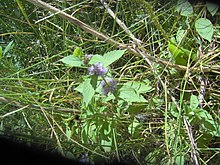Mentha canadensis
| Mentha canadensis | |
|---|---|

| |
| Wild Mint | |
| Scientific classification | |
| Kingdom: | |
| (unranked): | |
| (unranked): | |
| (unranked): | |
| Order: | |
| Family: | |
| Genus: | |
| Species: | M. canadensis
|
| Binomial name | |
| Mentha canadensis | |
Mentha canadensis (syn. M. arvensis var. canadensis) is a species of mint commonly known as American wild mint, native to North America (from Northwest Territories to central Mexico), eastern Asia (Siberia to Java) and the Northern Territory of Australia.[1] The flowers are bluish or a slight violet tint. The plant is upright about 4 inches (10 cm) to 18 inches (46 cm) tall. Leaves grow opposite from each other, and flower bunches appear at the upper leaf axil. The mint grows in wet areas but not directly in water, so it will be found near sloughs, lake and river edges. Flowers bloom from July to August.[2]

The related species Mentha canadensis is also included in Mentha arvensis by some authors as two varieties, M. arvensis var. glabrata Fernald (in reference to North American plants) and M. arvensis var. piperascens Malinv. ex L. H. Bailey (in reference to eastern Asian plants).[3][4]
Description
American wild mint is a perennial plant with an underground creeping rhizome and upright shoots. It can grow to a height of about 18 inches (460 mm). It has hairy stems bearing opposite pairs of leaves. Each leaf is borne on a short stalk and has a wedge-shaped base and is lanceolate or ovate, with a toothed margin and a hairy surface. The flowers are borne in spikes at the tips of the shoots. The flowers may be bluish, pink or white. They are arranged in a spiral around the inflorescence. Each flower has five sepals, four petals, four stamens and a superior ovary. The fruits are dry and split open when ripe releasing the two seeds.[5]
Uses
The leaves have a distinct peppermint smell when pinched or crushed as the plant contains aromatic oils. Pick leaves at any time during plant growth, and they may be dried. Mint jelly is a popular preparation. To make mint tea, pour boiling water over a scant teaspoon full of dried leaves, or over 1/3 cup fresh leaves. Iced tea is also a treat. Mint leaf candy can also be made.[6] First nations people use mint tea to remedy bad breath or toothache, or to cure hiccups. The mint can also be used for fox or lynx bait.[7]
References
- ^ Kew World Checklist of Selected Plant Families
- ^ Vance, F.R.; Jowsey, J.R.; McLean, J.S. (1977), Wildflowers Across the Prairies, Saskatoon, SK: Western Producer Books, p. 141, ISBN 0-919306-74-8
- ^ Germplasm Resources Information Network: Mentha canadensis
- ^ Quattrocchi, Umberto (1947), CRC World dictionary of plant names: Common names, Scientific Names, Eponyms, Synyonyms, and Etymology, vol. III M-Q, CRC Press, p. 1659
- ^ "Mentha canadensis: American wild mint". Go Botany. Retrieved 2013-12-10.
- ^ Elias, Thomas S; Dykeman, Peter A. (1990), Edible Wild Plants A North American Field Guide, New York NY: Sterling Publishing Company Inc., pp. 143–144, ISBN 0-8069-7488-5
- ^ Johnson Kershaw, MacKinnon Pojar (1995), Plants of the Western Boreal Forest and Aspen Parkland, Edmonton Alberta: Lone Pine Publishing and the Canadian Forest Service., p. 162, ISBN 1-55105-058-7
